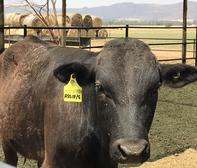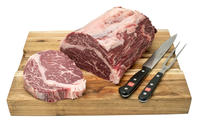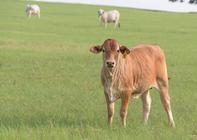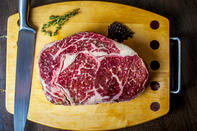The word Wagyu means “Japanese cow” and, as the name suggests, refers to a couple of cattle breeds that originated in Japan. Since Buddhist leaders prohibited the eating of flesh, these cattle were initially only selected on their ability to carry heavy loads.

This ban was lifted by the mid-nineteenth century, by which time the marbling of these breeds was already entrenched. Marbling is the word used for the intramuscular fat responsible for its succulent and flavoursome taste.
The quality of the meat proved so good that Wagyu beef, for many years, was reserved only for royalty and samurais in Japan. According to Wagyu International, the cattle during that time, were treated like members of the family, with households generally only keeping one or two.
The cattle were brushed and massaged to improve their blood circulation, keep their coats in good condition and evenly distribute fat. The constant handling helped to ensure the cattle were never exposed to stress that could have a negative impact on meat quality.
Today, however, these practices are disappearing with Wagyu farming households keeping an average of 43 head of cattle and some more than 200. In 2013, Wagyu International reported that there were over 52 000 breeders in Japan. In the old days, sake beer was also sometimes used as a coat conditioner and to stimulate the cattle’s appetite when it was hot. Some farmers, and not only in Japan, still include beer in their cattle’s diet.
International Production
International production only accounts for about 0.2% of all the breeds, in the premium meat market. There is still a lot of room for growth and the demand will continue to grow, due to the rising awareness of the excellent meat quality meat.Red Versus Black

According to Dr Michael Bradfield, CEO of the Wagyu Society of South Africa, there are two breeds of Wagyu produced in South Africa, namely red and black. The red coloured Wagyu, called Akauishi, has excellent marbling, good fertility and excellent growth.
They look similar to our indigenous red breeds of cattle. The Japanese black is slightly smaller in stature, but has even higher levels of marbling than the Akauishi and is ideally suited for the “boutique” meat market and exports. Australia has mostly Japanese black (about 300 000) and the United States has mostly Akauishi (about 100 000).
Local Production

Brian Angus introduced Wagyu to South Africa, when he imported the first embryos from the United States in 1999, which forms the foundation of his purebred herd. The Wagyu Society was established in 2014 and has grown to over 140 members by 2019.
At that time, the Society had about 3 000 cattle on its books, of which 1 200 were full blood and 300 were purebred. Bradfield says South Africa started producing Wagyu later than Australia and the United States, because it was difficult to procure embryo’s and the country was also essentially following European standards, which promoted the production of lean beef.
Over the past ten years, consumers have, however, realised the value of marbling as well as the health benefits of the fat in this meat.
Production Area
Wagyu cattle are highly adaptable and, therefore, produced throughout South Africa. The Wagyu Society promotes its use on mostly British and indigenous breeds such as Nguni, Bonsmara and Beefmaster, to enhance the meat quality, as well as the fertility of these breeds.Meat Quality

In 2018, the Wagyu Society of South Africa established a certification programme to ensure the integrity of the South African Wagyu beef supply chain and for quality assurance purposes. According to the breed definition, the term Wagyu may only be used for cattle sired by a registered full blood or purebred bull or for first line crossings with a minimum of 50% breed content.
Besides this, the meat should have a marbling score of at least three and be free of any hormones. Farmers need to comply with various ethical and animal welfare practices, keep thorough production records and bull calves need to be castrated before they are five months old.
By Glenneis KrielFor bulk or Wagyu Beef export enquiries please use the enquiry link below.